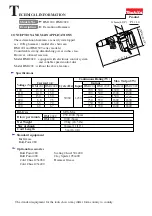
14
| English
Adjusting the Speed
You can adjust the speed of the power tool when it is on by
pressing in the on/off switch
(8)
to varying extents.
A light pressure on the on/off switch
(8)
results in a low rota-
tional speed. Increased pressure on the switch causes an in-
crease in speed.
Battery Charge Indicator
When the on/off switch
(8)
is pressed in halfway or com-
pletely, the battery charge indicator
(9)
indicates the bat-
tery's state of charge for several seconds. The indicator con-
sists of three green LEDs.
LED
Capacity
Continuous lighting 3 x green
≥ 66%
Continuous lighting 2 x green
33–66%
Continuous lighting 1 x green
≤ 33%
Flashing light 1 x green
Reserve
Temperature-dependent overload protection
In normal conditions of use, the power tool cannot be over-
loaded. If the power tool is overloaded or the permitted bat-
tery temperature is exceeded, the electronics of the power
tool will switch off until the temperature returns to within the
optimum operating temperature range.
Practical advice
u
Only apply the power tool to the screw/nut when the
tool is switched off.
Rotating tool inserts can slip off.
The torque depends on the impact duration. The maximum
achieved torque results from the sum of all individual
torques achieved through impact. Maximum torque is
achieved after an impact duration of 6–10 seconds. After
this duration, the tightening torque increases only minimally.
The impact duration is to be determined for each required
tightening torque. The tightening torque actually achieved
should always be checked with a torque wrench.
Screw applications with hard, spring-loaded or soft seats
When the achieved torques in an impact series are measured
during a test and transferred into a diagram, the result is the
curve of a torque characteristic. The height of the curve cor-
responds with the maximum reachable torque, and the
steepness indicates the duration in which this is achieved.
A torque gradient depends on the following factors:
– Strength properties of the screws/nuts
– Type of backing (washer, disc spring, seal)
– Strength properties of the material being screwed/bolted
together
– Lubrication conditions at the screw/bolt connection
The following application cases result accordingly:
– A
hard seat
is a metal-to-metal screw application which
uses washers. After a relatively short impact duration, the
maximum torque is reached (steep characteristic curve).
Unnecessary long impact duration only causes damage to
the machine.
– A
spring-loaded seat
is also a metal-to-metal screw ap-
plication but uses spring washers, disc springs, studs or
screws/nuts with conical seats. It is also called a spring-
loaded seat when extensions are used.
– A
soft seat
is a screw application of e.g. metal on wood or
a screw application that uses lead washers or fibre wash-
ers as backing.
For a spring-loaded seat as well as for a soft seat, the max-
imum tightening torque is lower than for a hard seat. Also, a
clearly longer impact duration is required.
Guide values for maximum screw tightening torques
Figures given in Nm; calculated from the tensional cross-section; utilization of the yield point: 90% (with friction coefficient
µ
total
= 0.12). As a control measure, always check the tightening torque with a torque wrench.
Property classes
according to
DIN 267
Standard screws/bolts
High-strength bolts
3.6
4.6
5.6
4.8
6.6
5.8
6.8
6.9
8.8
10.9
12.9
M6
2.71
3.61
4.52
4.8
5.42
6.02
7.22
8.13
9.7
13.6
16.2
M8
6.57
8.7
11
11.6
13.1
14.6
17.5
19.7
23
33
39
M10
13
17.5
22
23
26
29
35
39
47
65
78
M12
22.6
30
37.6
40
45
50
60
67
80
113
135
Tips
Before screwing larger, longer screws into hard materials, it
is advisable to pre-drill a pilot hole with the core diameter of
the thread to approx. 2/3 of the screw length.
Maintenance and Service
Maintenance and Cleaning
u
Remove the battery from the power tool before carry-
ing out work on the power tool (e.g. maintenance,
changing tool, etc.). The battery should also be re-
moved for transport and storage.
There is risk of injury
from unintentionally pressing the on/off switch.
u
To ensure safe and efficient operation, always keep
the power tool and the ventilation slots clean.
After-Sales Service and Application Service
Our after-sales service responds to your questions concern-
ing maintenance and repair of your product as well as spare
parts. You can find explosion drawings and information on
spare parts at:
www.bosch-pt.com
The Bosch product use advice team will be happy to help you
1 609 92A 4JH | (24.11.2020)
Bosch Power Tools















































